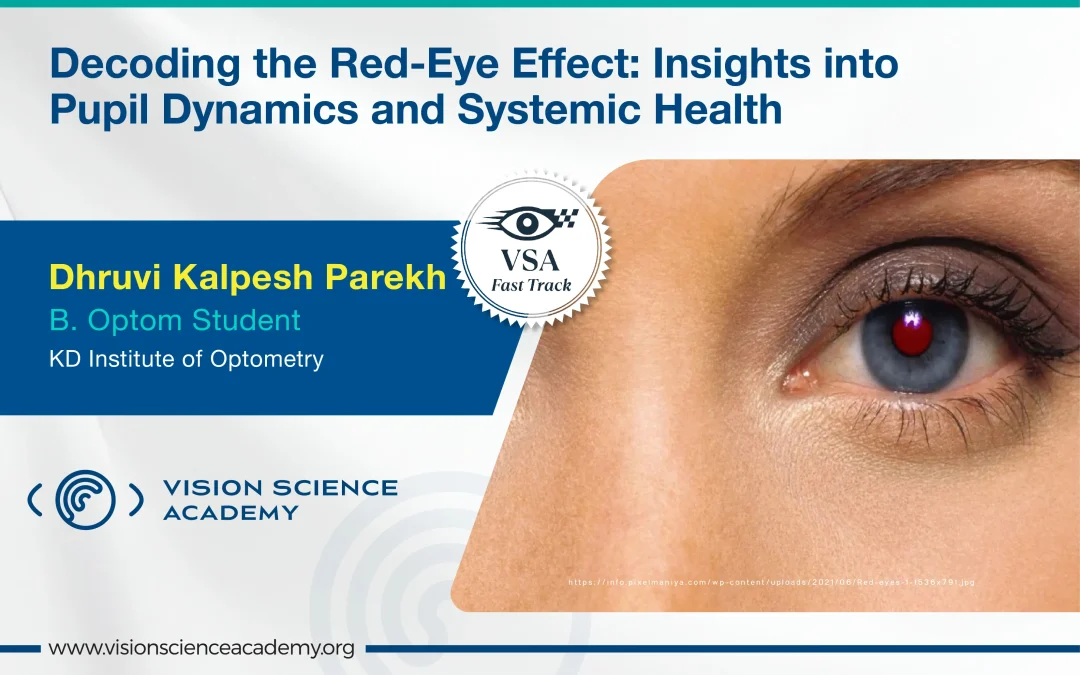Dhruvi Kalpesh Parekh, B.Optom. Student,
KD Institute of Optometry, Ahmedabad, India
The human pupil, a seemingly simple opening in the eye, is crucial for vision and overall health. From the red-eye effect in photography to its possible application in non-invasive medical diagnostics, pupil dynamics give important insights into physiological processes.
The Red-Eye Effect and Its Medical Applications
The red-eye effect happens when a camera flash bounces off the retina, particularly the choroid, a layer rich in blood vessels. This effect is amplified in low-light situations as pupils dilate, allowing more light to enter and producing a strong red reflection. While this phenomenon is commonly seen as a photographic fault, it has resulted in advances in medical imaging, notably in the monitoring of systemic blood oxygen levels. Recent research suggests that examining pupil reflections at certain wavelengths might serve as a proxy for systemic oxygenation levels. Researchers discovered a high link between optical density ratios in choroidal blood and pulse oximetry values, making this approach attractive for remote health monitoring.(1) This method has the potential to revolutionise non-invasive diagnostic tools in critical care and neurology.
Personalising Vision Care with Pupil Profiles
In addition to controlling light admission, the pupil reacts to a variety of external and cognitive stimuli. Studies demonstrate that pupil size is dynamically adjusted by internal mechanisms to maximise visual perception.(2)
Surprisingly, bigger pupils don’t necessarily equate to brighten object perception under some cognitive states, they can actually render objects darker.(3) In addition, pupil behaviour is affected significantly by age, gender, and refractive status, particularly in dimly lit situations.
Myopes will have larger scotopic pupils, improving vision in dim conditions, and hyperopic pupils gradually decrease in size with increasing age.(4) These discoveries are of critical clinical significance. They guide the design of prescription spectacle lenses and intraocular lenses (IOLs) to fit individual pupil shapes, enhance contrast sensitivity, depth of focus, and night time vision performance.
This evidence-based individualisation is a breakthrough point in the next generation of customised vision care.
Cognitive and Neurological Insights from Pupil Dynamics
Over the past decade, pupil size has also emerged as a non-verbal indicator of cognitive and neurological states. Experiments have shown that mental effort, emotional arousal, decision complexity, and memory recall all induce changes in pupil diameter. These changes, referred to as task-evoked pupillary responses (TEPRs), are strongly associated with activity in the locus coeruleus, a brainstem nucleus that regulates arousal and attention.
These discoveries have paved the way for applying pupillometry in the following areas:
- Neuropsychology: Measuring levels of mental fatigue or engagement in patients with cognitive impairments.
- Education: Measuring attentiveness in classrooms, especially in virtual classrooms.
- Human-computer interaction: Creating adaptive systems that react to the user’s level of engagement or stress.
As wearable infrared pupillometry and eye-tracking become increasingly available, pupil behaviour can be tracked in real time to diagnose conditions such as autism spectrum disorders, ADHD, and neurodegenerative conditions like Parkinson’s and Alzheimer’s.(5)
Conclusion
Pupil dynamics provide insights on perception, adaptability, and systemic health that go beyond simple light regulation. The relationship between pupil size and cognitive perception, the effect of refractive state on pupil diameter, and the potential for using pupil reflections for systemic oxygen monitoring are examples of how multidisciplinary research is revealing new uses for vision science.(1,3,4)
Ophthalmology, neurology, and remote diagnostics applications will all continue to develop as research progresses, opening up new avenues for comprehending human health and vision.
References:
- Remote sensing of blood oxygenation using red-eye pupil reflection Citation for published version. (2019). https://doi.org/10.1088/1361
- Schwiedrzik, C. M., & Sudmann, S. S. (2020). Pupil diameter tracks statistical structure in the environment to increase visual sensitivity. Journal of Neuroscience>, 40>(23). https://doi.org/10.1523/JNEUROSCI.0216-20.2020
- Wardhani, I. K., Boehler, C. N., & Mathôt, S. (2022). The influence of pupil responses on subjective brightness perception.51>(6), 370–387. https://doi.org/10.1177/03010066221094757
- Yılmaz, T., & Özçelik, F. (2022). The influence of brightness, age and refractive errors on pupil size. Anatomy>, 22>(3), 146–151. https://doi.org/10.2399/ana.22.3207380
- Haj, M. El, Chapelet, G., Moustafa, A. A., & Boutoleau-Bretonnière, C. (n.d.). Pupil size as an indicator of cognitive activity in mild Alzheimer’s Disease>. https://hal.science/hal-03796515v1


Recent Comments